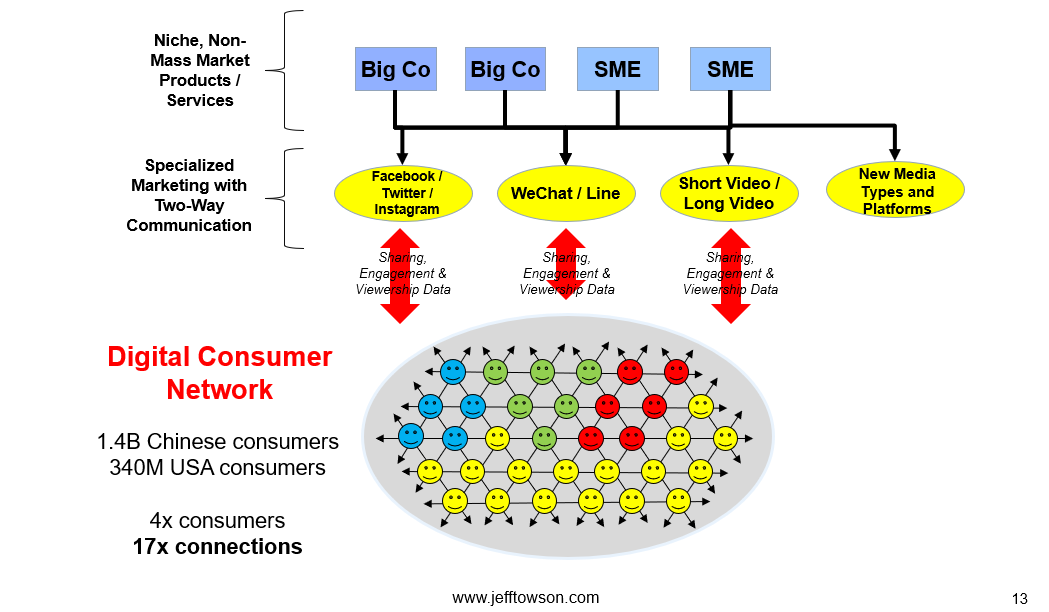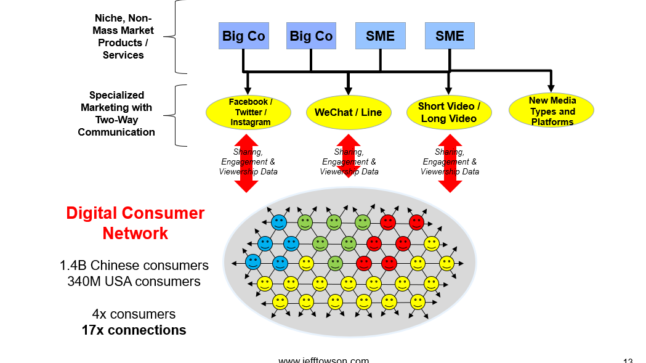I like China as a market for business and investment.
- It’s really big. The GDP is $19T (about the same as the EU).
- It’s really innovative. Silicon Valley has about 450,000 software engineers. China graduates about 1.4M engineers per year.
- Innovation and increasing productivity mean growth. The macro GDP growth numbers are nonsense. But you can find sectors with 10-15% growth (ecommerce is really good).
- It has some of the world’s strongest businesses. There are lots of lessons and business models to copy. I do a lot of speaking on lessons from the digital giants of China.
- Prices are low because lots of investors are spooked by China. There really isn’t much China knowledge in the West. People don’t know how to think about the government role. And this type of vacuum is fertile ground for emotion and stupid punditry. Most of the media narratives around China are pretty stupid.
- Everyone is ambitious and entrepreneurial. This is the cultural aspect nobody talks much about. The place hums with ambition and entrepreneurialism. It’s everywhere.
So how do you think about China?
Easy.
Just look for the situations that are easy to understand. Don’t try to understand everything. Just understand a few important things.
And three particularly important things have happened in China in the past decade.
- Chinese consumers finally started spending money after decades of working and saving. Chinese consumers are now the first or second largest market in the world for most consumer businesses. And they are showing the biggest growth. Think 25% of all growth in private consumption is from China. Only the USA is similar. This is a big tailwind.
- Chinese consumers are hyper-connected 24/7 via their smartphones, both to businesses and to each other. They are super adopters. And they are always connected and reachable.
- Chinese consumer behavior is digital-first. Most everything in consumer China begins with smartphones and the behavior there.
So you have a great consumer spending tailwind.
And you have a mechanism for activating this spending in a powerful way. Which is a digital network.
My conclusions is that Chinese consumers are now acting like a +1B person, interconnected network, which I call the China Digital Consumer Network. And it is really, really powerful. Here’s how business used to work.

But when consumers are connected as a network they look like this. It’s not a uniform demographic. It is highly segmented and connected.

And that makes B2C in China look like this:

Why the CDCN is so powerful:
- It is consumers, not enterprises, who are the engine of digital China. We are seeing some rapid adoption of B2B and enterprise, but it has mostly been a consumer phenomenon.
- This has a lot to do with the big spending power mentioned. But it also has to do with the mass adoption of smartphones and the fact that Chinese consumers are always on, very enthusiastic and digital-first in their behavior. The overall enthusiasm and changes in consumer behavior were not something people predicted. New mobile apps are just adopted very rapidly. There is tons of sharing, interactions, transactions, content production and consumption. By virtually every measure, the speed and volume of interactions between people on smartphones in China has been exploding.
- Businesses that tap into this network can take off at incredible speed. This is TikTok. It’s WeChat. It’s mobile payment. It’s KOLs creating content. It’s live-streaming. And so on.
- All of this activity is resulting in tons of data, something China now has a huge advantage in on the consumer side. By mining this data, you get rapid introductions of new products and services, increasingly useful machine learning and AI technologies, and more precise targeting and customization.
For example:
- Reviews, experiences and word of mouth spread rapidly and broadly. A company’s brand and image are now far more determined by what connected Chinese consumers say than by what the company says. If you have a service in China, a hotel in New York or a restaurant in France, Chinese consumers are talking about you online.
- Content is widely shared. This is why short-videos, long-videos, live-streaming and KOL content mostly came out of China.
- Good and bad events about a company can go viral within hours. Even companies that don’t do much business in China, like United Airlines, have discovered this to their surprise.
- About 25% of retail in China is now done via e-commerce, which means tons of money moving within the CDCN. Think $2T per year.
A couple more points.
Point 1: The China Consumer Network Is Cash Rich
Let’s take a moment and stand in awe of Chinese e-commerce.
It is huge. Add up all the e-commerce of France, Germany, Japan, the United Kingdom, and the United States combined – and China is still bigger. Online retail sales are now over $2 trillion, representing +30% of China’s total retail sales volume (it depends on sub-sector).
So what happens when this type of money flows within a network – between consumers and to businesses (who are also often SMEs and solopreneurs)?
Some amazing things can happen. For example:
- Connected Chinese consumers can be powerful marketing agents for clever companies. Digital marketing initiatives by companies like L’Oréal and Burberry are designed to get consumers to talk about their experiences or respond to challenges. And this user created content and commentary that spreads in the CDCN.
- Connected Chinese consumers can be powerful sales agents for companies, as shown by the stratospheric rise of group buying e-commerce site Pinduoduo. It is sometimes called social commerce but it is really just about getting consumers to convince other consumers to buy stuff. Really any product or service that is naturally viral (i.e., its use brings new users on board) can take off incredibly quickly. Examples are WeChat, Alipay, Zoom and other communication, payment and collaboration tools.
If you can activate the CDCN as a business, it can result in a lot of money moving very quickly.
Point 2: The China Digital Consumer Network Is Becoming a Consumer-Producer Network
Everything I have mentioned so far has been about consumer interacting with each other – and with businesses. But what happens when these same connected consumers, start becoming small businesses or producers themselves?
Once you have consumers connected, it is often just a short step for them to start acting as producers of content, goods and services.
They can easily go from buying products online to selling things online as a small merchant on Taobao.
They can go from being a renter to starting to rent their own home on Tujia or Airbnb.
And they can definitely go from consuming content to creating content, like videos, podcasts and blogs.
For example:
- Connected Chinese consumers are now powerful producers of content, as shown by how easy it is to create short videos on Douyin.
- Connected Chinese consumers are increasingly becoming service providers. Unlike in the US and Europe, China has a massive pool of low cost labor that is now able to sell their services to consumers on the network. They are now offering basic, standardized services like cooking, cleaning, delivery and rides. And we are increasingly seeing higher skilled and more differentiated services like accounting, design, legal and IT support.
Going from a consumer network to a consumer-producer network is a quantum jump in the number of interactions happening (even though the number of nodes in the network stays the same). And it also leads to producer-producer interactions (another big increase).
Point 3: The CDCN Is Driving Business Behavior and Services
Everyone doing business with Chinese consumers, whether in China or abroad, is struggling to keep up with their rapidly evolving digital behavior. Digital-first consumers are forcing businesses to change their behavior and development. And to make it more suitable for digital behavior.
- If you are marketing and selling to the China digital consumer network, that means digital marketing and social media first. It means KOLs. It doesn’t matter if you are a shopping mall in Shanghai, a tour operator in Paris or an exporter in Mexico, you have to be up to speed on the latest events in Chinese digital marketing and social media. You have to understand the newest features on WeChat, Weibo and Little Red Book. More and more multinationals, like Zara and Budweiser, now consider China their innovation hub for digital marketing globally.
- And when it comes to payment, you have to accept mobile payments. Because that is how Chinese consumers expect to pay for things. Try paying in cash in China. If you are a hotel or café in Thailand, try not accepting Alipay.
- Cheap and fast delivery is also now the norm. Chinese consumers are now longer willing to wait 3-5 days for anything. For e-commerce, they expect delivery today or maybe in 1-2 days. For food and coffee they expect it in like 20-30 minutes. Note: Starbucks ignored digital and delivery in China and gave Luckin Coffee an opening. Starbucks then rapidly partnered up with Alibaba to offer delivery.
So you can see we almost have a virtuous cycle.
- Chinese consumers are a +1B digital-first network and this is forcing businesses to change their operations.
- Which then makes their services superior for a digital age.
- Which then makes consumers more digital-first in their behavior.
Point 4: The CDCN Is Also Driving the Creation of Digitally Superior Infrastructure
It gets better.
Not only are digital-first consumers leading to more digitally savvy businesses. They are also resulting in infrastructure that is superior for digital behavior by both consumers and businesses.
Look at how rapidly the infrastructure in China is changing with regards to:
- Payment and credit (and financial services). Mobile payment is just a better solution for consumers. You always have your phone. So you can buy anywhere you go. You can scan and buy bikes on the streets. You can buy while watching videos. You can even buy what you see in the videos. Mobile payment is just better. And we are also seeing instantly approved micro-credit for e-commerce purchases. We are seeing supply chain credit for e-commerce merchants. There is micro-gifting for online performers. Payment, credit, insurance and other types of financial services are rapidly changing in China and are providing a digitally superior type of infrastructure that others can build upon.
- Smart logistics and delivery. This is another area where China is in the lead. Logistics networks that are increasingly intelligent and automated are being built by companies like Cainiao and JD Logistics. They can deliver anything, anywhere. And they are extending globally. Durians can be picked in Thailand on Monday and timed for delivery to a Chinese consumer on Thursday when they are at peak ripeness.
- Regulations. The new regulations, especially around e-commerce, tend to be more digitally savvy in China than in the US and definitely in Europe. And they are definitely better than in India.
- Physical stores for retail and services. China is now far ahead in reimagining the physical assets of retail and in combining them with online. Alibaba’s Freshippo stores are a mix of retail space, service center and logistics hub. Compare that with Amazon’s struggle to integrate with Whole Foods and their handful of Amazon Go stores.
- Smart cities. About half of the world’s 1,000 smart city pilot projects are in China. As the streets, subways, traffic lights, utilities, and government / security services become increasingly smart and connected via cloud, AI, IoT sensors, cameras, and other tools, cities are becoming like operating systems that apps and services can run on.
Again, it’s almost another virtuous cycle.
- The +1B digital-first consumer network is driving changes in businesses and infrastructure.
- Which are enabling more possibilities for services and pushing consumers towards a more digital-first lifestyle.
Final Point: All of This is More Powerful in Developing Economies
This cycle of digital-first consumers driving the creation of digital-first businesses and infrastructure is more powerful in developing economies. Because it gets you a bigger improvement in the consumer experience, which drives faster adoption.
Retail, payment / financial services, communication and such are far less developed in India and Southeast Asia than in the US so these digital tools get the consumer a much bigger jump in the user experience. Mobile payments are bigger deal in China because people mostly didn’t have credit cards. All of this means faster adoption of new digital tools.
Developing economies also have bigger problems and greater urgency in areas such as pollution, food safety, traffic and congestion, corruption and crime, and poverty. This also drives the adoption of digital tools.
***
Ok. That’s it for today.
Have a great day and thanks for reading, – jeff
———-
Related articles:
- A Digital Strategy Breakdown of Salesforce. Spoiler: It’s Awesome (1 of 3) (Tech Strategy – Daily Article)
- A Strategy Breakdown of Arm Holdings (1 of 3) (Tech Strategy – Daily Article)
- 3 Digital Concepts Powering ARM Holdings (2 of 4) (Tech Strategy – Daily Article)
From the Concept Library, concepts for this article are:
- China Digital Consumer Network
From the Company Library, companies for this article are:
- n/a
———–
I am a consultant and keynote speaker on how to accelerate growth with improving customer experiences (CX) and digital moats.
I am a partner at TechMoat Consulting, a consulting firm specialized in how to increase growth with improved customer experiences (CX), personalization and other types of customer value. Get in touch here.
I am also author of the Moats and Marathons book series, a framework for building and measuring competitive advantages in digital businesses.
Note: This content (articles, podcasts, website info) is not investment advice. The information and opinions from me and any guests may be incorrect. The numbers and information may be wrong. The views expressed may no longer be relevant or accurate. Investing is risky. Do your own research.
